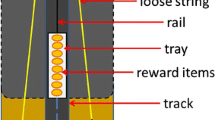Abstract
Cooperative interactions vary in complexity. The emotional reactivity hypothesis posits that cooperative complexity is constrained by social intolerance. Relaxed social constraints should thereby increase cooperative flexibility and have been proposed as a key step in cognitive evolution. Lions (Panthera leo) are an ideal candidate for investigating cooperative complexity and tolerance. Lions regularly cooperate and their egalitarian social structure predicts high social tolerance. I used a food-sharing task and cooperative problem-solving task to investigate tolerance and cooperation in lions. The majority of pairs (N = 5/7 dyads) solved the cooperative task, repeated success in consecutive trials, and demonstrated cooperative complexity at the levels of similarity and synchrony. Surprisingly, lions showed no evidence of coordination. If coordination occurred, then after gaining experience and when no longer naïve to the need for a partner, lions should increase the proportion of time spent together and preferentially attended to the task in the presence of a partner. However, naïve and experienced pairs did not differ (Wilcoxon matched-pair signed-rank test: both present at apparatus: S4 = − 4.5, N = 5, p = 0.50 |both touching the rope: S4 = − 3.5, N = 5, p = 0.43| simultaneous action: S4 = 2.5, N = 5, p = 0.63). As predicted, lions displayed high tolerance and cooperative success was positively correlated with tolerance (Spearman’s correlation test: ρ = 0.83, N = 7, p = 0.02*). To date, this is the first experimental test of and support for cooperative problem solving in lions.




Similar content being viewed by others
References
Anderson JR (2007) Animal behavior: tolerant primates cooperate best. Curr Biol 17:R242–R244
Anderson C, Franks NR (2001) Teams in animal societies. Behav Ecol 12:534–540
Boesch C (1994) Cooperative hunting in wild chimpanzees. Anim Behav 48:653–667
Boesch C (2002) Cooperative hunting roles among Tai chimpanzees. Human Nat 13:27–46
Boesch C, Boesch H (1989) Hunting behavior of wild chimpanzees in the Tai National Park. Am J Phys Anthropol 78:547–573
Borrego N, Gaines M (2016) Social carnivores outperform asocial carnivores on an innovative problem. Anim Behav 114:21–26
Brosnan SF, Salwiczek L, Bshary R (2010) The interplay of cognition and cooperation. Philos Trans R Soc Lond B Biol Sci 365:2699–2710
Byrne RW, Whiten A (1988) Machiavellian intelligence: social expertise and the evolution of intellect in monkeys, apes, and humans. Clarendon Press, Oxford
Cheney DL (2011) Extent and limits of cooperation in animals. Proc Natl Acad Sci USA 108(Suppl 2):10902–10909
Courchamp F, Macdonald DW (2001) Crucial importance of pack size in the African wild dog Lycaon pictus. Anim Conserv 4:169–174
Crawford MP (1937) The cooperative solving of problems by young chimpazees. Comp Psychol Monogr 14:1–88
Creel S, Creel NM (1995) Commual hunting and pack size in African wild dogs, Lycaon pictus. Anim Behav 50:1325–1339
Drea CM, Carter AN (2009) Cooperative problem solving in a social carnivore. Anim Behav 78:967–977
Fanshaw JH, Fitzgibbon CD (1993) Factors influencing the hunting success of an African wild dog pack. Anim Behav 45:479–490
Gazda SK, Connor RC, Edgar RK, Cox F (2005) A division of labour with role specialization in group-hunting bottlenose dolphins (Tursiops truncatus) off Cedar Key, Florida. Proc Biol Sci 272:135–140
Grinnell J (2002) Modes of cooperation during territorial defense by African lions. Human Nat 13:85–104
Hare B (2007) From nonhuman to human mind. Curr Directo Psychol Sci 16:60–64
Hare B, Tomasello M (2005) The emotional reactivity hypothesis and cognitive evolution. Trends Cogn Sci 9:464–465
Hare B, Melis AP, Woods V, Hastings S, Wrangham R (2007) Tolerance allows bonobos to outperform chimpanzees on a cooperative task. Curr Biol 17:619–623
Heinsohn R, Packer C (1995) Complex cooperative strategies in group-territorial African lions. Science 269:1260–1262
Heinsohn R, Packer C, Pusey AE (1996) Development of cooperative territoriality in juvenile lions. Proc Biol Sci 263:475–479
Hubel TY, Myatt JP, Jordan NR, Dewhirst OP, McNutt WJ, Wilson AM (2016a) Additive opportunistic capture explains group hunting in Africa wild dogs. Nat Commun 7:1–11
Hubel TY, Myatt JP, Jordan NR, Dewhirst OP, McNutt JW, Wilson AM (2016b) Energy cost and return for hunting in African wild dogs and cheetahs. Nat Commun 7:11034
Humphrey NK (1976) The social function of intellect. In: Bateson PPG, Hinde RA (eds) Growing points in ethology. Cambridge University Press, Cambridge
Kitchen DM, Packer C (1999) Complexity in vertebrate socieites. In: Keller L (ed) Levels of selection in evolution. Princeton University Press, New Jersey, pp 176–196
Kuczaj SA 2nd, Winship KA, Eskelinen HC (2015) Can bottlenose dolphins (Tursiops truncatus) cooperate when solving a novel task? Anim Cogn 18:543–550
McComb K, Packer C, Pusey A (1994) Roaring and numerical assessment in contests between groups of female lions, Panthera leo. Anim Behav 47:379–387
Melis AP, Hare B, Tomasello M (2006) Engineering cooperation in chimpanzees: tolerance constraints on cooperation. Anim Behav 72:275–286
Moslinger H (2009) Cooperative string-pulling in wolves (Canis lupus). Universitat wien, Vienna, Austria
Mosser A, Packer C (2009) Group territoriality and the benefits of sociality in the African lion, Panthera leo. Anim Behav 78:359–370
Noë R (2006) Cooperation experiments: coordination through communication versus acting apart together. Anim Behav 71:1–18
Packer C, Pusey A (1994) Non-offspring nursing in social carnivores: minimizing the costs. Behav Ecol 5:363–374
Packer C, Pusey A (1997) Divided we fall: cooperation among lions. Sci Am 276:32–39
Packer C, Ruttan L (1988) The evolution of cooperative hunting. Am Nat 132:159–198
Packer C, Scheel D, Pusey AE (1990) Why lions form groups: food is not enough. Am Nat 136:1–19
Packer C, Pusey A, Eberly LE (2001) Egalitarianism in female African lions. Science 293:690–693
Peron F, Rat-Fischer L, Lalot M, Nagle L, Bovet D (2011) Cooperative problem solving in African grey parrots (Psittacus erithacus). Anim Cogn 14:545–553
Plotnik JM, Lair R, Suphachoksahakun W, de Waal FB (2011) Elephants know when they need a helping trunk in a cooperative task. Proc Natl Acad Sci USA 108:5116–5121
Reader SM, Laland KN (2002) Social intelligence, innovation, and enhanced brain size in primates. Proc Natl Acad Sci USA 99:4436–4441
Rose LM (1997) Vertebrate predation and food-sharing in Cebus and Pan. Int J Primatol 18:727–765
SAS (2012) JMP Version 10. SAS Institute Inc., Cary
Schaller GB (1972) The Serengeti lion: a study of predator-prey relations. University of Chicago Press, Chicago
Scheel D, Packer C (1991) Group hunting behavior of lions: a search for cooperation. Anim Behav 41:697–709
Seed AM, Clayton NS, Emery NJ (2008) Cooperative problem solving in rooks (Corvus frugilegus). Proc Biol Sci 275:1421–1429
Stander PE (1992) Cooperative hunting in lions: the role of the individual. Behav Ecol Sociobiol 29:445–454
Team RC (2015) R: A language and environment for statistical computing. R Foundation for Statistical Computing Viena, Austria
Visalberghi E, Quarantotti BP, Tranchida F (2000) Solving a cooperation task without taking into account the partner’s behavior: the case of the capuchin monkeys (Cebus apella). J Comp Psychol 114:297–301
Acknowledgements
I would like to thank Lion Country Safari and The Kevin Richardson Wildlife Sanctuary for access to their facilities and assistance in research. I thank Lion Country Safari for constructing and funding the puzzle boxes, and specifically, Brian Dowling for his invaluable assistance throughout this study. I would also like to thank Bob Dalton at Lion Country Safari for his help constructing the puzzle boxes. The University of Miami also provided funding for this project. I am also grateful to Kevin Richardson and the staff of Welgedacht Private Game Reserve for their assistance during research, specifically: Lozanne van Sittert, Ian Hall, and Zako Jordaan. Craig Packer, Steve Green, and Bill Searcy provided feedback and support throughout the various stages of this project and I am grateful for their guidance.
Author information
Authors and Affiliations
Corresponding author
Additional information
Publisher's Note
Springer Nature remains neutral with regard to jurisdictional claims in published maps and institutional affiliations.
Electronic supplementary material
Below is the link to the electronic supplementary material.
Supplementary material 1 (MOV 24084 kb)
Supplementary material 2 (MP4 33400 kb)
Rights and permissions
About this article
Cite this article
Borrego, N. Socially tolerant lions (Panthera leo) solve a novel cooperative problem. Anim Cogn 23, 327–336 (2020). https://doi.org/10.1007/s10071-019-01336-4
Received:
Revised:
Accepted:
Published:
Issue Date:
DOI: https://doi.org/10.1007/s10071-019-01336-4




